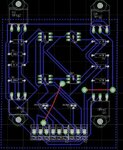nin82
Newbie level 5
Hi, I decided to build this H-bridge to drive a power window motor which is rate at 12v 8A and it works to the point that it will switch the motor's direction BUT if I put a load (i.e hold it with my finger tips to make it stop rotating) on the motor the tips(142 & 147) will just heat up and the motor wont move at all i first thought the lines on the PCB were to thin but when i hook the tips by them self's with thicker wire i get the same result. its almost as if the tip142 and 147 were not designed for high currents also i hooked my psu (the yellow line and black 12v 20A) to thin telephone wire and then to the power window motor and it worked like it should. what am i doing wrong?? are the resistors to small??? they are 1/2watt. I am running out of ideas.
I Have attached the eagle files brd and sch if its of any help
thanks for reading8-O
I Have attached the eagle files brd and sch if its of any help
thanks for reading8-O
Attachments
Last edited:

